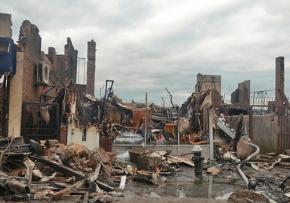The flood next time
One year after Hurricane Sandy struck, New Yorker and author of America's Got Democracy! doubts that his hometown is ready for the next big storm.
ON OCTOBER 20 of last year, I did standup at a party in Chelsea for the book I had just written called America's Got Democracy!
The joke that got the biggest laugh, which I will now ruin by writing it out, was about how the supposedly "stark choice" between Democrats and Republicans around global warming isn't the different things they're going to do about it, but the different ways they say they're not going to do anything about it. While the Republicans still pander to the climate change deniers, I said, the Democrats have a different approach--they say:
You're wrong, Republicans--climate change is real, and it's very serious. And we're not going to do anything about it. But somebody really should because it's quite scary. Maybe we could write a letter or something.
Nine days later, Hurricane Sandy put whole swaths of the coastal Northeast underwater, Chelsea was blacked out for days, and parts of the outer boroughs for much longer, and my joke didn't seem so funny.
Sandy bluntly confirmed that climate change and rising sea temperatures are not terrible things of the future, but terrible things right now. It made New Yorkers much more aware of our geography--specifically, that most of us live on an archipelago or a series of islands. It suddenly mattered that the names of many of our neighborhoods end in "Beach" or "Island."

LIVING IN a part of Queens that ends with "Heights," I was fortunate to experience the hurricane as little more than a heavy rain, so I volunteered in the Rockaways, an 11-mile long strip of land that is home to 130,000 people. At the height of the storm, most of it was under five feet of water. When a local told me this fact on my first day there, I didn't quite believe him until he pointed out clearly visible five feet high water mark on every building – except those that had been destroyed by fire.
I ended up in Rockaway through my friendship with the incredible Nastaran Mohit, an Occupy and labor activist who within days of the storm had set up a medical clinic in Rockaway Beach. Nastaran's team of volunteer nurses and social workers found hundreds of frightened people with serious medical needs trapped in blacked-out, high-rise apartments, without elevator service.
Meanwhile, government and NGO relief agencies were nowhere in sight. For a solid week after Sandy hit, the only government officials who would venture beyond the FEMA trailer parks were National Guard troops on patrol to prevent looting.
One morning, I heard Mayor Michael Bloomberg on the radio announce that the city had sent mobile health teams to the Rockaways. Nastaran assigned me to find these teams so we could coordinate our efforts. I spent hours leaving unreturned messages with city agencies and walking to parking lots, where officials from city and federal emergency agencies told me they had no idea about any such teams.
The official disarray and neglect was shocking, even for some of us who were socialists and anarchists. It was sobering and scary that three decades of budget cuts and "big government is the problem" ideology has rendered the state incapable of the basic function of protecting and aiding the population--not just under George W. Bush in majority Black New Orleans, but under Barack Obama in the wealthiest city in the world.
After a few days of "look at these crazy pictures" gawking, the media focus shifted to how Sandy would impact President Obama's re-election hopes (look, he and Chris Christie are praising each other!) and the efforts to get the financial district running again. As Sean Petty pointed out at the time, Bloomberg set this tone by choosing to attend the opening bell of the New York Stock Exchange instead of the dramatic evacuation of hundreds of patients from two blacked-out hospitals that occurred on the same day.
Bloomberg faced some backlash for his ill-fated attempt to let the New York Marathon happen as scheduled, within miles of Staten Island neighborhoods that had seen the highest death tolls in the city. Bloomberg attempted to justify by saying, "I think for those who were lost...you've got to believe they would want us to have an economy and have a city go on for those that they left behind."
Overall, however, the plight of poor and working-class areas of Staten Island, Brooklyn, and Queens that were rocked by Sandy faded into the background, especially as the problems created by the storm blended into the already existing crises of poverty and a frayed social safety net. One of the Rockaways' two hospitals, for example, had closed down earlier in the year, which meant that the emergency room of the other hospital was overburdened before Sandy even hit.
The incredible relief efforts organized by Occupy Sandy and other volunteer efforts were occasionally acknowledged in the media, but usually in feel-good stories about the nobility of the relief workers rather than exposés of the scandalous conditions that made their work necessary. Some Occupy Sandy activists tried to resist this marginalization by organizing protests and media campaigns, but they had limited success.
I was surprised at how little understanding people outside the flood zones seemed to have of the gravity of situation. When I told friends and family about the situation in the Rockaways, the phrase I heard again and again was: "I knew it was bad, but not that bad." I heard it from New Yorkers living within miles of hard-hit areas. I heard it from a meeting of socialists in Los Angeles that I spoke to via Skype. I heard it from people who were reading the articles that I and other journalists were writing and had access to alternative media and Facebook, but who couldn't quite internalize it until they heard the fear and sadness in my voice.
It made me think about a trip my family had taken to upstate New York the year before. We tried taking a shortcut off the expressway and wound up tangled in a maze of closed off-roads in a region that had been nailed by Hurricane Irene the previous week. Stopping for lunch, we got directions from a guy whose house had been flooded up to the second floor with toxic chemicals. The whole town was basically destroyed, he said, as he helpfully gave us detailed directions for getting to I-90.
Back in New York City, Hurricane Irene had been a highly anticipated dud, and Facebook filled up with "I survived Irene" memes. One of them was just a lawn chair on its back in a back yard, which I thought was funny, even though I was aware that the storm had been no joke upstate and in Vermont.
I knew it was bad, just not that bad.
A YEAR since Hurricane Sandy hit New York City, little has changed beyond public relations. Michael Bloomberg, as is his specialty, garnered headlines and applause for a couple of statements regarding climate change that he has shown little sign of backing up with action.
Within days of Sandy, Bloomberg announced that he would endorse Obama for president based on Obama's having a better position on climate change than Mitt Romney. (I'm back to thinking that my joke was funny, by the way.) Then this summer, the mayor announced a decades-long $20 billion plan to protect New York City from future storms sure to arise due to global warming.
But in Bloomberg's final months in office, there has been a flurry of plans for more buildings built on the water's edge across Queens, from Long Island City to Astoria to Flushing--as if Sandy never happened.
Meanwhile, Bloomberg and his "Independence PAC" have been silent as Obama has deliberated on whether to approve construction of the Keystone XL pipeline, which would enable the emission of so much carbon from the Canadian tar sands that NASA climate scientist James Hansen said it would be "game over" for preventing catastrophic climate change if the project goes through.
And New York City continues to lose hospitals, even as we know we are going to face more climate-related health emergencies. Three hospitals in Brooklyn are facing closure, which would leave a borough of 2.5 million people with only five emergency rooms. Incredibly, St. John's Episcopal, the lone remaining hospital in the Rockaways, is facing closure.
It feels like we are on a ship heading into a storm with no one at the helm. We know that hurricanes and floods will continue and grow worse because we are increasing the emission of carbon through hydro-fracking and deep-sea drilling, and yet we are making ourselves less prepared for these disasters by building more on the waterfront and weakening our health care infrastructure.
More than any other experience in my life, Hurricane Sandy strengthened my resolve to keep working towards the day that the people will be strong enough to break into the control room and turn this boat around.


